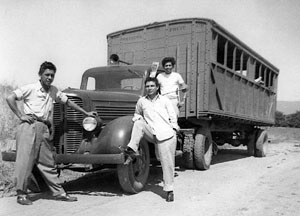 |
 |
 |
 News from Around the Americas | January 2007 News from Around the Americas | January 2007  
Mexico's "Braceros" Revive Campaign to Secure Pension Payments
 Associated Press Associated Press


| | The program stems from the Spanish word for arm, "brazo," and refers to their manual labor. It was intended to recruit hardy men to pick crops, lay railroad tracks and work on ranches for several years - then send them back to their hometowns in Mexico. |
Salinas, Calif. - Mexican laborers who worked in Texas, California and other agricultural states from 1942 to 1964 will embark this week on another letter-writing campaign to lobby the Mexican government for reimbursements.

The men - former members of the "bracero" guest worker program - say Mexico's federal government deducted 10 percent of their earnings, ostensibly putting the money in a pension fund in Mexico City. Now that the workers are retired, they want the payments - even if they've emigrated to the United States.

The program stems from the Spanish word for arm, "brazo," and refers to their manual labor. It was intended to recruit hardy men to pick crops, lay railroad tracks and work on ranches for several years - then send them back to their hometowns in Mexico. About 400,000 workers participated.

It's unknown exactly how many stayed, but it's clear that thousands joined the undocumented work force after escaping their job sites, while others got sponsored by an employer and became permanent residents.

Ten years ago, when braceros on both sides of the border began pressuring the U.S. and Mexican governments to reimburse them, about 1,000 braceros in Salinas filled out forms to demand payments of about $3,000 each.

Jesus Vargas Correa, 83, began coming to the United States as a bracero in 1953, when he harvested olives in Madera. He also picked cotton in Texas, tomatoes in Stockton and grapes in Corcoran. He began lobbying for reimbursements about 10 years ago but hasn't received a dime.

He and other members of a Salinas-based bracero group have been meeting for months and, with the help of the Salinas-based networking agency Citizenship Project, plan to renew their letter-writing campaign this week. They also took their concerns to the Mexican consulate, where officials have forwarded the message to Mexico City, said Jose Loreto, acting Mexican consul in San Jose.

Loreto emphasized that the Mexican government has not announced any program to include more braceros in the reimbursement funds, but the administration of President Felipe Calderon may consider the issue.

"The new government has to listen to their petitions," Loreto said. "Somebody has to present their case so they're taken into consideration." | 
 | |
 |



